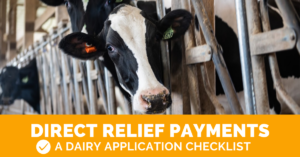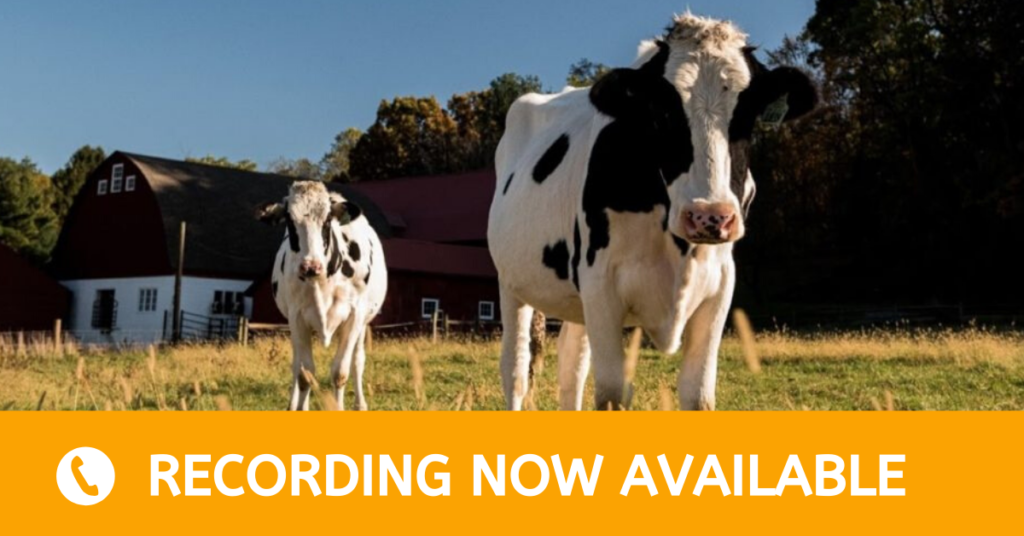
They Will Begin Accepting Applications on May 26
On May 19, 2020, U.S. Secretary of Agriculture Sonny Perdue announced details of the Coronavirus Food Assistance Program (CFAP), which will provide up to $16 billion in direct payments to deliver relief and direct support to farmers who have experienced losses related to COVID-19.
Beginning Tuesday, May 26, the USDA, through the Farm Service Agency (FSA), will begin accepting direct payment applications from agricultural producers who have suffered losses.
According to the USDA, dairy producers’ total payment will be calculated based on a producer’s certification of milk production for the first quarter of calendar year 2020 multiplied by a national price decline during the same quarter. The second part of the payment is based a national adjustment to each producer’s production in the first quarter.
Keep reading for important information on dairy eligibility, how payments will be calculated, payment timelines, and how you can begin preparing your application for when sign-ups open on Tuesday, May 26.
What to Know About Applying for Direct Relief Payments
New Updates
In addition to relief payments for milk production and dumped milk, dairy farmers are eligible for payments on cull cows, bull calves, steers, and dairy heifers sold into the beef market. Cull dairy cows are eligible for payment under the category of “Slaughter Cattle: Mature Cattle” and young stock are eligible under one of the two Feeder Cattle categories depending on weight.
Silage is eligible for CFAP if the production was owned as of January 15, 2020 and subject to price risk if the production had been sold on January 15, 2020. Alfalfa or forage crops are are ineligible for the program.
View a full list of eligible commodities and payment rates.
Milk production enrolled in risk management programs also qualifies for CFAP payments. Qualifying risk management programs include:
- Livestock Gross Margin
- Dairy Revenue Protection
- Dairy Margin Coverage
Application Checklist
Dairy producers can begin submitting direct payment applications on May 26.
STEP ONE: Gather the information you need.
- Receipts of cull cows sold January through April.
- Inventories of grain not under contract and inventories of corn silage for what’s on hand as of January 15 paid on grain conversion
- Settlement milk checks for January through March
- Direct deposit information
STEP TWO: Call your local FSA office to make an appointment when the application period opens on May 26.
*Producers can also enroll for CFAP payments online and do not have to set up an appointment with FSA as long as they have been an FSA customer in the past and have all of the FSA forms in place. The USDA has provided the following payment calculator, which gives producers the option to print the application after entering their data, and then sign it and submit it to their County FSA Office by email, fax, or mail. Download the payment calculator if you’d like to submit your application this way.
- Dairy producers must apply through their local FSA office by appointment only. Once the application period opens on May 26, call your FSA county office to schedule your appointment. Note: Your FSA office may be inundated with calls when sign-ups open, so be patient and build in some time on Tuesday.
- FSA staff will work with you to file applications. Applications will be submitted electronically either by scanning, emailing, or faxing. Documentation to support your application and certification may be requested.
- Applications will be accepted through August 28, 2020.
- Click here to find the FSA office in your county.
STEP THREE: During your appointment, work with your FSA office to complete the following forms using the information you gathered in Step One. They may also already have them on hand for you.
- Form CCC-901— Identifies members of a farm or ranch that is a legal entity; Member names, addresses, Tax ID#, and citizenship status
- CCC-941— Reports average adjusted gross income for programs where income restrictions apply
- CCC-942— If applicable, certifies income from farming, ranching, and forestry for those exceeding income limits
- Form AD-1026— Ensures compliance with highly erodible land conservation and wetland conservation
- Form AD-2047— Provides basic customer contact info
- Form SF-3881— Collects bank information and permission to deposit funds by direct deposit
- FSA is not requiring an acreage report at the time of application, and a USDA farm number may not be immediately needed.
- In addition to the application form, their staff will work with producers to complete portions of the CCC-902 – Farm Operating Plan – if necessary.
- Learn more about the application forms.
Payment Levels
Dairy
For dairy, a single payment will be made based on a producer’s certification of milk production for the first quarter of calendar year 2020 multiplied by $4.71 per hundredweight. For dairy, a single payment will be made based on a producer’s certification of milk production for the first quarter of calendar year 2020 multiplied by $4.71 per hundredweight. The second part of the payment is based on multiplying first quarter production by the national adjustment factor of 1.014 to adjust for increased spring milk production in the second quarter, then multiplying that by $1.47 per hundredweight.
The payment amounts to approximately $6.20/cwt. for a farm’s production in January through March of this year.
Livestock
Livestock eligible for CFAP include cattle, lambs, yearlings and hogs. The total payment will be calculated using the sum of the producer’s number of livestock sold between January 15 and April 15, 2020, multiplied by the payment rates per head, and the highest inventory number of livestock between April 16 and May 14, 2020, multiplied by the payment rate per head.
At this time, any cattle maintained as part of the dairy operation, which includes bulls for breeding and bull calves maintained for possible replacement/addition to the breeding program (for dairy cattle production) would not be eligible under the livestock portion of the program. If bulls were used for breeding specifically for dairy production and then sold between January 15 and April 15, 2020, they can count towards the sales only if they are sold for slaughter. If bulls or bull calves were sold to another dairy operation for breeding purposes, they cannot be included.
Bulls and bull calves that are intended for beef can be included in the highest inventory between April 16 and May 14, 2020. Bull calves are included in the feeder cattle – less than or greater than 600 lbs. categories. Dairy cows sold between January 15 and April 15, 2020 as cull cows intended for slaughter are eligible for payment under “slaughter cattle: mature.”
When can you expect your initial payment?
To ensure the availability of funding throughout the application period, producers will receive 80 percent of their maximum total payment upon approval of the application. The remaining portion of the payment, not to exceed the payment limit, will be paid at a later date as funds remain available.
Eligibility
CFAP payments are eligible to all dairy operations with milk production in January, February, and/or March 2020. Any dumped milk production during the months of January, February, and March 2020 is eligible for assistance.
Milk production enrolled in risk management programs, such as Livestock Gross Margin, Dairy Revenue Protection, or Dairy Margin Coverage, also qualifies for CFAP payments. However, it is unclear at the time if milk production covered by forward contracts through CME/cooperatives during January – March will be eligible for payments. Clarification is expected prior to May 26.
Silage is eligible for CFAP if the production was owned as of January 15, 2020 and subject to price risk if the production had been sold on January 15, 2020. Alfalfa or forage crops are are ineligible for the program.
Payment Limitations
In general, there is a payment limitation of $250,000 per person or entity for all commodities combined. Applicants who are corporations, limited liability companies or limited partnerships may qualify for additional payment limits where members actively provide personal labor or personal management for the farming operation.
- CFAP payments are subject to a per person and legal entity payment limitation of $250,000. This limitation applies to the total amount of CFAP payments made with respect to all eligible commodities.
- Corporate entities (including limited liability companies and limited partnerships) may receive up to $750,000 based upon the number of shareholders (not to exceed three shareholders) who are contributing substantial labor or management with respect to the operation of the corporate entity.
- A corporate entity may receive more than $250,000 in CFAP payments if the applicant, under penalty of perjury, self-certifies that two or three members of the corporation each provided at least 400 hours of active personal labor or active personal management or combination thereof with respect to the production of 2019 commodities for which an application or applications are made.
- A person or legal entity, other than a joint venture or general partnership, is ineligible for payments if the person’s or legal entity’s average adjusted gross income (AGI), using the average of the adjusted gross incomes for the 2016, 2017 and 2018 tax years, is more than $900,000, unless at least 75 percent of that person’s or legal entity’s average AGI is derived from farming, ranching, or forestry-related activities. With respect to joint ventures and general partnerships, this AGI provision will be applied to each member of the joint venture and general partnership.
Learn About Direct Payments – Listen to Recording of Dairy Industry Call

During our recent dairy industry conference call, our panelists shared valuable information about the CFAP direct payment application process and answered common questions from producers. If you were unable to join the call, a recording is now available.
About CFAP
CFAP provides vital financial assistance to producers of agricultural commodities who have suffered a five-percent-or-greater price decline due to COVID-19 and face additional significant marketing costs as a result of lower demand, surplus production, and disruptions to shipping patterns and the orderly marketing of commodities.

